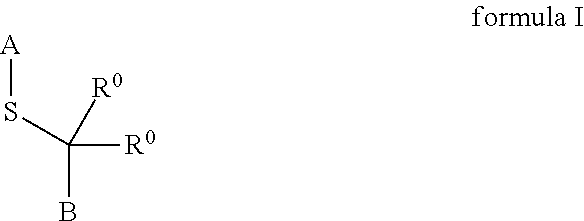Radio-and chemo-protective compounds
a technology of radioprotective compounds and compounds, applied in the field of compounds, can solve the problems of hematopoietic, gastrointestinal, neurovascular cells, and the most vulnerable to adverse effects, and is more likely to be exposed to harmful amounts of space radiation, so as to and reduce the risk of secondary tumor induction.
- Summary
- Abstract
- Description
- Claims
- Application Information
AI Technical Summary
Benefits of technology
Problems solved by technology
Method used
Image
Examples
example 1
of di-tert-butyl (2-(mercaptomethyl)propane-1,3-diyl)bis (methylcarbamate) (PrC-210-Boc2)
[0567]
[0568]Intermediate PrC-210-Boc2 is synthesized according to Scheme 5. Double chloride displacement from 3-chloro-2-(chloromethyl)prop-1-ene with two equivalents of N-methyl mesitylene-sulfonamide followed by hydroboration-oxidation generates the corresponding sulfonamide alcohol. The alcohol is converted to a sulfonate ester upon addition of mesyl chloride to the reaction mixture. Subsequent treatment with thioacetic acid followed by deprotection of the amine under acidic conditions generates the deprotected thioate derivative. The tert-butoxycarbonyl (Boc) protected compound (PrC-210-Boc2) is then synthesized upon treatment with di-tert-butyl decarbonate. For exemplary reaction conditions, see Copp, R. R.; Peebles, D. D.; Fahl, W. E., Bioorg. Med. Chem. Lett., 2011, Vol. 21(24), pp 7426-7430; and US2014 / 107216.
example 2
of Intermediate di-tert-butyl (2-((phosphonothio)methyl)propane-1,3-diyl)bis(methylcarbamate) (Prc-210-PT-Boc2)
[0569]
[0570]Intermediate PrC-210-PT-Boc2 is synthesized according to the procedure summarized in Scheme 6. Phosphorylation of PrC-210-Boc2 is afforded upon treatment with bis(9H-fluoren-9-ylmethyl)-diisopropylamidophosphite followed by oxidation with t-butyl hydroperoxide. Subsequent deprotection under basic conditions affords intermediate PrC-210-PT-Boc2. For exemplary reaction conditions, see Dorfmueller, H. C.; Borodkin, V. S.; Blair, D. E.; Pathak, S; Navratilova, I.; Van Aalten, D. M. F.; Amino Acids, 2011, Vol. 40, pp 781-792.
example 3
of Compound 1-{[3-(methylamino)-2-[(methylamino)methyl]propyl]sulfanyl} phosphonic acid (PrC-210-PT)
[0571]
[0572]Compound 1 is synthesized as depicted in Scheme 7. Double chloride displacement from 3-chloro-2-(chloromethyl)prop-1-ene with two equivalents of N-methyl mesitylene-sulfonamide followed by hydroboration furnishes the corresponding sulfonamide alcohol. The alcohol is converted to the corresponding bromide upon treatment with triphenylphosphine dibromide. Subsequent addition of lithium thiophosphate affords compound 1 (PrC-210-PT). For exemplary reaction conditions see Laval, J. D.; Roman V.; Laduranty, J.; Miginiac, L.; Lion, C.; et al., Eur. J. Med. Chem., 1993, Vol. 28 (9), pp 709-714; Carrol, F. I.; Gopinathan, M. B.; Philip, A., J Med. Chem. 1990, Vol. 33(9), pp 2501-2508; Copp, R. R.; Peebles, D. D.; Fahl, W. E., Bioorg. Med. Chem. Lett., 2011, Vol. 21(24), pp 7426-7430; Moene, W.; Vos, M.; Schakel, M.; De Kanter, F. J. J; Schmitz, R. F.; Klumpp, G. W., Eur. J. Chem., ...
PUM
| Property | Measurement | Unit |
|---|---|---|
| pH | aaaaa | aaaaa |
| median survival time | aaaaa | aaaaa |
| median survival time | aaaaa | aaaaa |
Abstract
Description
Claims
Application Information
 Login to View More
Login to View More - R&D
- Intellectual Property
- Life Sciences
- Materials
- Tech Scout
- Unparalleled Data Quality
- Higher Quality Content
- 60% Fewer Hallucinations
Browse by: Latest US Patents, China's latest patents, Technical Efficacy Thesaurus, Application Domain, Technology Topic, Popular Technical Reports.
© 2025 PatSnap. All rights reserved.Legal|Privacy policy|Modern Slavery Act Transparency Statement|Sitemap|About US| Contact US: help@patsnap.com



